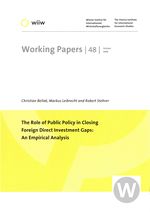The Role of Public Policy in Closing Foreign Direct Investment Gaps: An Empirical Analysis
Christian Bellak, Markus Leibrecht and Robert Stehrer
wiiw Working Paper No. 48, October 2008
23 pages including 8 Tables
Using public policy instruments to attract Foreign Direct Investment (FDI) has become standard in most countries, irrespective of their level of development, geographical location or industrial structure. Against this background the paper analyses the suitability of various public policies to attract inward FDI stock based on a sample of 11 countries and 10 industries from the manufacturing sector over 10 years. For this aim we derive an empirical baseline model of the determinants of inward FDI stock. From this baseline model, FDI gaps - measured as the difference between the 'estimated actual' inward FDI stock and the 'potential' FDI stock which could be realized if a certain 'best practice policy' were carried out - are derived. The analysis focuses on business taxation, public research and development expenditures, the information and communication infrastructure endowment, labour costs as well as institutional and skill-related policies. The analysis inter alia reveals the share of each of these location factors in the total industry- and country-level FDI gap.
Keywords: economic policy, foreign direct investment, European Union, industry-level study, location decision
JEL classification: F21, H25, H71
Countries covered: Austria, Czechia, Germany, Hungary, Slovakia, Slovenia, USA, Finland, France, Netherlands, United Kindom, Visegrad countries
Research Areas: International Trade, Competitiveness and FDI
